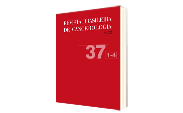Study models for inducing tumors by 7,12-dimethylbenz (A) - Antracene in rat mammary gland
DOI:
https://doi.org/10.32635/2176-9745.RBC.1991v37n1/4.3103Palavras-chave:
câncer mamário, DMBA, glândula mamária de rato, estudo de modelosResumo
Cinco modelos de estudo (A, B, C, D, E) foram usados para investigar o efeito do 7,12-dimetilbenz(a)antraceno em induzir tumores no tecido mamário de ratas Sprague-Dawley. Cada grupo foi submetido ad libitum às seguintes dietas: grupo A - ração comercial; grupos B e C - uma dieta semipurificada rica em ácido linoléico; grupo D - uma dieta semipurificada rica em ácido graxo saturado; grupo E uma dieta gordurosa composta de 50% de óleo de soja (rico em ácido graxo essencial), 25% de óleo de oliva (rico em ácido oleico) e 25% de óleo do coco (rico em ácido graxo saturado). Os animais receberam, através de instilação intra gástrica, uma ou duas doses de DMBA dissolvidas em 1 ml de óleo de soja. Os animais do grupo A receberam uma dose simples de 10 mg de DMBA, 60 dias após o nascimento. Os animais do grupo 8 receberam duas doses de 20 mg de DMBA, a primeira dose 45 dias após o nascimento e a segunda 60 dias após o nascimento. Os animais dos grupos C, D e E foram tratados da mesma maneira que os animais do grupo B. Os grupos-controle receberam 1 ml de placebo, óleo de soja. O DMBA induziu tumores nos ratos tratados como visualizado nos seguintes resultados: 1) Os grupos A, B, C, D e E desenvolveram 52%, 76%, 88%, 60% e 67% de tumores, respectivamente. 2) Nos grupos-testes A, B, C, D e E, o primeiro tumor palpável foi visto a 200 ± 52, 103 ± 36, 48 ± 1, 133 ± 62 e 183 ± 45 dias após a administração do DMBA, respectivamente. 3) 14,8%, 40,7%, 97,5% e 41,7% de todos os tumores foram classificados como adenocarcinomas.Os resultados sugerem que o modelo de estudo "C" foi o mais efetivo, induzindo, o maior, incidência de adenocarcinomas nos ratos tratados por DMBA, os sintomas foram evidentes no menor tempo experimental.
Downloads
Referências
HUGGINS C, BRIZIARELLI G, SUTTON H. Rapid induction of mammary carcinoma in the rat and the influence of hormone on the tumors. J Exp Mcd 1959; 109: 25-54. DOI: https://doi.org/10.1084/jem.109.1.25
HUGGINS C, GRANO LC, BRILLANTES FP. Mammary cancer induced by a single feeding of polynuclear hydrocarbons and its supression. Nature 1961; 189: 204-207. DOI: https://doi.org/10.1038/189204a0
DIGIOVANNI J, JUCHAU MR. Biotransformation and bioactivation of 7, 12-dimethylbenz(a)anthracene (7,12-DMBA). Drug Metab Ver 1980; 11(1):61-101. DOI: https://doi.org/10.3109/03602538008994022
MILLER EC. Some current perspectives on chemical carcinogenesis in humans and experimental animals: presidential address. Cancer Res 1978; 38: 1479-1496.
RUSSO J, WILGUS G, RUSSO 1H. Susceptibility of the mammary gland to carcinogenesis. 1. Differentiation of the mammary gland as determinant of tumor incidence and type of lesion. Am J Pathol 1979; 96: 721-736.
PURNELL DM. The relationship of terminal duct hyperplasia to mammary carcinoma in 7, 12-dimethylbenz(a)anthracene-treated LEW/ Mai rats. Am J Pathol 1980; 98:311-324.
ALVARENGA M, CAVALCANTI TC, TAHIN OS. Histopathologic grading system for epitelial abnormalities induced by 7,12-dimethylbcnz(a)anthracene (DMBA) in female rat mammary tissue. Breast Dis 1989; 2:71-79.
CARROLL KK, GAMMAL EB, PLUNKTT ER. Dietary fat and mammary cancer. Cand Mcd Ass J 1968; 98: 590-594.
CARROLL KK. Summation: which fat/how much fat animaIs. Prev Mcd 1987; 16: 510-515. DOI: https://doi.org/10.1016/0091-7435(87)90065-X
KRITCHEVSKY D. Lipids and cancer. In: Arnott MS, van Eys J, Wang Y-M, eds. Molecular Interrelations of Nutrition and Cancer. NewYork: Raven Press 1982: 209-217.
ABRAHAM S, FAULKIN II, HILLYARD LA, MITCHELL DJ. Effect of dietary fat on tumorigenes in the mouse mammary gland. J Nath Cancer lnst 1984; 72(6): 1421-1429.
SELENKAS SL, lP MM, IP C. Similarity between trans fat and saturated fat in the modification of rat mammary carcinogenesis. Cancer Res 1984; 44: 1321-1326.
ABOU-EL-ELA SH, PRASSE HW, CARROLL R, WADE AE, DHARWADKAAR S, BUNCE OR. Eícosanoid synthesis in 7,12- dimethylbenz(a)anthracene-induced mammary carcinoma in Sprague-Dawley rats fed primose, menhaden oil or com oil diets. Lipids 1988; 23: 948-954. DOI: https://doi.org/10.1007/BF02536342
TAHIN OS, CAVALCANTI TC. The effect of dietary lipids in the fatty acid composition of mammary mitochondria of female rat treated with 7,12-dimethylbenz(a)anthracene. Breast Dis 1991; in press.
CARROLL KK. Fish oils and cancer. ln: Chandra RK, ed. Health Etíects of Fish Oils. St. John's, Newtoundland: ARTS Biomedical Publishers & Distributors, 1989:395-408.
JACOBSON EA, JAMES KA, NEWMARK HL, CARROLL KK. Effects of dietary fat, caicium, and vitamin D on growth and ma-mmary tumorigenesis induced by 7,12-dimethylbenz(a)anthracene in female Sprague-Dawley rats. Cancer Res 1989; 49: 6300-6303.
CARROLL KK. Experimental and epidemiological evidence on marine lipids and carcinogenesis. ri: Less RS, Karol M. eds. Omega-3 fatty acids in health and disease, New York: Marcel Dekker Inc., 1990: 99-114. DOI: https://doi.org/10.1201/9781003066453-5
RUSSO J, RUSSO IH. Biology of disease. Biological and molecular bases of mammary carcinogenesis. Lab lnvest 1987; 57(2): 112-137.
CAVALCANTI TC, MELLO RA, De CAMARGO AM, TAHIN OS. Mammary mitochondria ATPase of female rats treated by DMBA and two lipid diets. IRCS Mcd Sci 1986: 14: 1161-1162.
Downloads
Publicado
Como Citar
Edição
Seção
Licença

Este trabalho está licenciado sob uma licença Creative Commons Attribution 4.0 International License.









